Salmon run season: Witnessing the remarkable resilience of chum
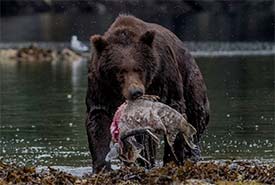
Bear with salmon (Photo by Bobushphoto via Getty Images Signature/Canva)
As the wind strips the trees of their leaves, and mushrooms surface through the rain-soaked ground, autumn takes hold along the Pacific Northwest of Canada. The changing season brings one of the most spectacular cycles of nature in the world. Millions of salmon embark on a long and treacherous journey from the Pacific Ocean to their place of birth in the mountainous streams of British Columbia. This season is an important celebration for many British Columbians. We flock to streams across the province in the thousands to witness this natural wonder. And it never gets old, year after year. Trust me.
Goldstream Park salmon run
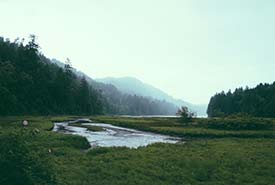
Estuary at Goldstream Provincial Park (Photo by Paul Jarvis on Unsplash)
I’m lucky enough to live close to Goldstream Park, where I can catch a glimpse of thousands of chum salmon as they forge their way upstream. Nestled in an abundant old-growth forest filled with dew-covered ferns, moss, Douglas firs, and western red cedars, Goldstream runs through an ancient and vital ecosystem on the traditional territory of the Malahat, Pauquachin, Tseycum, Tsartlip and Tsawout First Nations. Not far from the busy road is the stone-packed stream where visitors congregate to catch a glimpse of one of nature’s greatest events.
Salmon life cycle
If they manage to complete their full life cycle, salmon begin and end their lives in the same gravel bed as where they started at the end of fast-flowing rivers and streams. Adult salmon nearing the end of their lives deposit thousands of eggs in these spawning grounds. As nurseries, these environments are safer than the currents of the Pacific Ocean. After a few months, the eggs hatch into larvae (alevin). According to the Vancouver Aquarium, alevin “live off the nutritious yolk sac that hangs off their undersides,” while continuing to live in the safety of the gravel bed for a few more months. As these salmon babies (fry) mature, they eventually leave the safety of the nursery in search of food, such as plankton. By the end of the summer, they grow into juvenile fish (parr), a stage in which they remain for a few years as they feed and grow into strong adults.
As they prepare to migrate to the ocean, they enter the smolt stage, and undergo physiological changes. During this time, they live in estuaries that act as transition zones between river and marine environments. This ensures the smolt successfully adapt from fresh water to salt water.
Once they’re mature enough, they enter the post-smolt stage. During this period, they travel to rivers and the ocean, where they join schools of post-smolt fish that travel to deep-sea feeding grounds. They spend the next few years growing into adult salmon. And then, just like that, they collectively embark on one of the longest migrations in the animal kingdom, which begins the salmon cycle of life once again. At Goldstream Park, we only catch a glimpse of their long journey home.
What it’s like to witness a salmon run
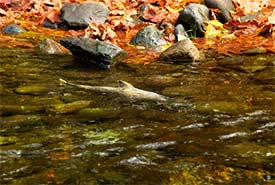
Salmon run (Photo by Pri2s via Getty Images/Canva)
While the salmon run is undoubtedly spectacular to view, it’s actually incredibly quiet and meditative. It’s truly a multisensorial experience. You can smell the pungent perfume of chum carcasses, while listening to the gentle trickling of the stream. You become mesmerized by clusters of salmon calmly fluttering in the water. Every so often you catch a splash or jump, much to the excitement of the crowds. Glaucous-winged gulls patiently wait above before swooping down the stream in hopes of capturing a tasty feast. And if you’re lucky enough, you may even catch a glimpse of a black bear in a distant wetland.
Salmon as keystone species
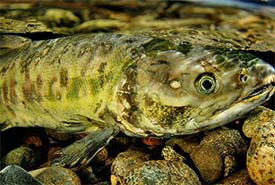
As the season progresses, more and more salmon carcasses fill the shoreline. While I’m often saddened by the thought of their long and arduous journeys coming to a premature end, I take comfort in the fact that their bodies give back to the forest and to the species that inhabit it.
In the Great Bear Rainforest, located along the Pacific Coast of British Columbia, salmon play a vital role in the health of the ecosystem. In this temperate rainforest, over 2,500 salmon runs take place each year. Many species rely on salmon as a seasonal food source, including bears, otters, wolves, orcas, loons and humans. These species even closely align their natural cycles with salmon spawning season so they can take advantage of the abundance of food available, whether in the water or as carcasses along the shore.
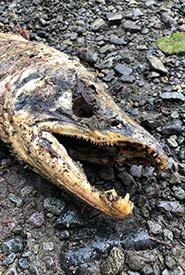
Chum salmon carcass (Photo by Jaime Clifton-Ross)
So how do salmon take care of their ecosystems? They nourish trees, insects, algae, mosses and shrubs by enriching the rainforest’s living soil with nitrogen, sulfur, carbon and phosphorus. This process takes place when other larger species, like bears and wolves, drag their carcasses through the forest. Because salmon are at the centre of an essential system taking place in the rainforest, they are often considered a keystone species.
I’m always struck by the incredible resilience of salmon. While I gaze upon their sparkling scales as they gently sway underwater, I can’t help but think of how tired they must be. While some salmon seem to be stuck at a standstill, others are thrust backwards by unrelenting currents before mustering enough strength to carry on. All while battling the currents, they dodge endless parades of hungry bears and birds. Whatever their fate, I take comfort in knowing that their incredible migratory instinct is the source for so much life, even in death.
This blog is reposted with permission and originally appeared on the National Environmental Treasure's website.


